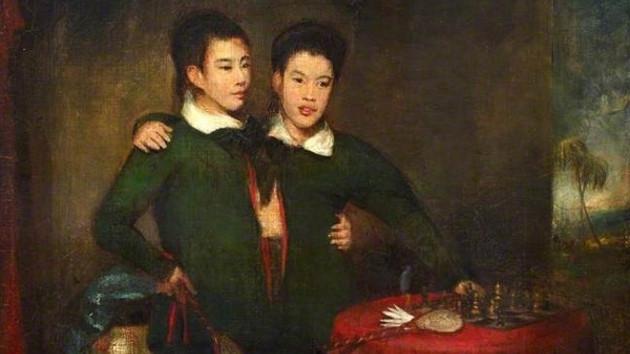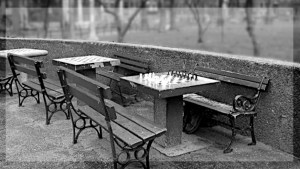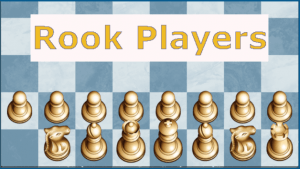
Siamese Chess

Chang and Eng were the "original" Siamese twins. Born in Siam in 1811, their father died when they were 8 and so for 10 years they eked out a living selling duck eggs until their mother, for a lump sum and a promise for a better life, allowed the 18 year olds to travel with a Scottish trader, Robert Hunter, who discovered them by accident and saw their potential as money-makers. In partnership with Abel Coffin, the captain of the ship transporting them, Hunter put the twins on a tour of Boston, Providence, Philadelphia, New York, London, Dublin and other cities. Afterwards they joined P.T. Barnum's circus as sideshow exhibits. When they reached age 21, the twins, now adults, took control of their own lives and toured the US, charging 50 cents admission to their show. After touring for about 7 years in the US and Europe, they settled in the small North Carolina community of Traphill where they bought a 1000 acre farm in 1839. Eventually marrying local sisters (1843) and gaining US citizenship, they adopted "Bunker" as their surname. They acquired 33 slaves to work the farm. In 1846 the two families, now with children (eventually to number 21 total - 22 by some accounts), moved to Mt. Airy, North Carolina. They bought separate houses, a mile apart, for each family where Chang-Eng would alternate living every three days. Already strapped for money in 1860, the Civil War soon stripped them of some of their land and all their slaves. Chang and Eng were forced to give exhibitions once again but much of the novelty had worn off. Chang, who had suffered from a stroke in 1870 died in his sleep from pneumonia on Jan. 17, 1874. Eng died 4 hours later.

Signatures of Chang and Eng
Though each has a distinct mind, yet their organization endows them with great sympathy, for they sleep nearly at the same time. They enjoy an excellent appetite, and are very vivacious. They walk with their arms twined around each other's necks like two friends. They play chess, and have often beaten strangers at this difficult game. They will also converse separately with different persons at the same time. One is named Chang, the other Eng; but they are frequently called together Chang-Eng. —"The Pictorial Family Encyclopedia of History, Biography and Travels," 1854
Their act was something of a marvel in itself. Chang-Eng, as they were often called, did acrobatics, somersaults, feats of both strength and intelligence. While their original managers took up to 90% of the profits for themselves, and traveled first-class while resigning the twins to the freight area, once they broke free from that indentured servitude, they accumulated a small fortune from their hard work and frugality. In their act they tried to portray themselves as of one mind, but a very cultured one, offerering to play members of the audience games of chess, draughts or whist. Often, the twins were depicted with a chess or checker board.
"These exhibitions evolved through the years. At their first showing in Boston, a city of 61,000 residents in 1829, the twins simply stood on stage, demonstrated how they walk and run, and answered questions. Soon, they wowed audiences in Providence, R.I., with somersaults, backflips and a show of strength —carrying the largest audience member, who weighed in at around 280 pounds. In England, Chang-Eng added a badminton-like game —battledore and shuttlecock— to the act." —"Eng & Chang: a Hyphenated Life" by Page Chichester

While no games scores have been passed down, we do know that chess was one of their hobbies that was often incorporated into their exhibition.
"If the audience was particulalry responsive, they would challenge members to a game of checkers or chess to demonstrate their intelligence." —"New York Before Chinatown" by John Kuo Wei Tchen
"Their mental operations were entirely distinct too, and in playing chess against an adversary, they consulted one another about the next move." —"The Pictorial Cabinet of Marvels" by Harrison Weir, 1878.

This 1830 lithograph depicts the twins with a checkerboard

Chang-eng with a racket and chessboard
a contemprary watercolor drawing made in England by Daniel Maclise

Another English drawing circa 1830.
Chang is moving a chess piece

Chang-Eng playing badminton with a chess set in the background.

hangs in the Hunterian Museum at the Royal College of Surgeons in England.

This 1839 image from a souvenir postcard shows the twins with a chessboard.
An article in "Life" magazine, Aug. 11, 1952 entitled, "Cheng-Eng's American Heritage," tells us:
"In Britain the twins became expert at battledore and shuttlecock (battledore was the racket; shuttlecock, the bird in a game that later became badminton), a game they included in ther performance, and at checkers and chess. They did not confine their appearances to stuffy public halls; once they advertised a Chang-Eng excursion on a river steamer with the paying public invited to cruise with the, ('they will be happy to take a partner in a game of whist')."
Later in the article it explains:
"Now, as a penalty for their worldwide fame and for the hocus-pocus showmanship of Barnum, their marriages became the subject of immense quantities of gossip and speculation. Part of their professional act had been to present as identical appearance and to exaggerate their unity of thought and action. Chang, for example, one inch shorter than his brother, always wore a heavy-soled shoe to make up the difference, and it was stated erroneously that they never disagreed and would not play chess with each other because 'it would be too much like the right hand playing against the left.'"
Chang and Eng Bunker, Buddhists-turned Baptists, are buried in the White Plains Baptist Church yard in Mt. Airy. Not only did they help build the church, they donated the land upon which it was built.
The tragedy of their lives, although being conjoined twins might also be viewed as the means to a unique existance, was that they were joined together by a relatively small band of cartilage at their sternum. Their livers thoughconnected were completely individual and they shared a very minimum of blood. Today, according to many prfessional accounts, their separation would be a relatively simple proceedure and even in those days a possible one, at least in their later lives.

plaque at White Plains Baptist Church

Monument at White Plains Baptist Church Yard

Chang-Eng with wives and one of each of their sons.
L-R: Sarah Yates Bunker, Eng Bunker ; Chang Bunker, Adelaide Yates Bunker.
L-R: Christopher Wren Bunker, named after the English architect, Sir Christopher Wren; Stephen Decatur Bunker, mamed after Commodore Stephen Decatur, Jr.
Shortly after their death, T. P. Bull sent the following problem pair that he named Siamese Twins to the "Dubuque Chess Journal." Each problem has twin solutions:

Chang: Solution #2
Eng: Solution #1
Eng: Solution #2






